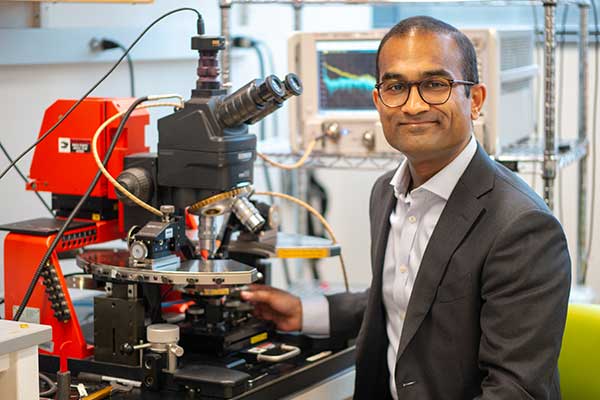Ghosh Receives DARPA Young Faculty Award To Improve All-Acoustic RF Signal Processing

Siddhartha Ghosh, assistant professor, electrical and computer engineering (ECE), has been awarded a $500,000 Young Faculty Award from the Defense Advanced Research Projects Agency (DARPA) to create single-platform microsystems that can incorporate active functionality with passive acoustic wave (AW) devices at radio frequencies.
Ghosh’s research is called Compound Semiconductor on Piezoelectric Strongly Confined Microacoustic Integrated Circuits (COSMIC), and it seeks to achieve its goal by incorporating acoustoelectric (AE) functions with phononic integrated circuits (PnICs) for novel AW devices.
“Using current communication technologies, if you want to incorporate some gain—i.e., an amplified signal—you have to go in and out of the acoustic domain, which results in a loss of signal,” says Ghosh. “By developing a single platform for all-acoustic RF signal processing (RFSP) covering high frequency through super high frequency bands, we can unlock new potential in AW devices with improved radio receivers and chip sets, reduced system complexity, and more resilience to intentional third-party signal interference.”
Ghosh’s proposal also seeks to develop systems that are capable of full duplex communication, or the ability to transmit and receive at the same time.
“The challenge with full duplex communication is that is it’s akin to trying to hear a whisper while you’re shouting,” says Ghosh. “However, if you can talk and listen at the same time, you can double your spectrum utilization; this is a problem that has been sought after in all wireless communication domains, both military and commercial, so the potential applications are widespread.”
While many researchers have worked on improving gain by implementing different amplifiers and signal processing elements over several decades, Ghosh aims to leverage advances in both new materials and processing technology over the last 15 years to solve the issue.
“In recent years, several trends have offered new opportunities for realizing the vision of integrated AE RFSPs, such as the emergence of high electromechanical coupling modes in materials such as AlScN thin films, compound semiconductor technology with unprecedented carrier mobilities, the maturation of heterogeneous integration technologies, and nanofabrication techniques,” says Ghosh.
Ghosh’s research will leverage several of Northeastern’s resources, including the George J. Kostas Nanoscale Technology and Manufacturing Research Center. Furthermore, Northeastern is the only academic institution in the country hosting a foundry‐compatible cluster tool for the deposition of high‐quality AlN/AlScN piezoelectric thin‐films on 8‐inch wafers.
In addition to RF signal processing, Ghosh’s COSMIC PnICs may also have future applications in quantum information processing using phonon buses or addressing challenges around microwave-to-optical frequency conversion.
Related Story: Engineering professor wants to revolutionize wireless communication by manipulating ‘acoustic waves in solids’